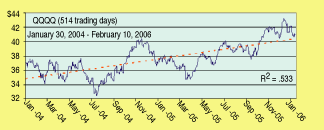Know What To Trade
Trade The Chart, Not The System
by Anthony Trongone, PhD, CFP, CTA
This is why you need to constantly monitor the performance of your trading system.
Changing economic conditions can affect the performance of any trading system. Therefore, developing the discipline to periodically monitor the performance of your systems becomes a constructive exercise, one that can increase profits or prevent loss.
The proactive trading system (referred to as "GIA," which stands for "generating interactive assets") is a successful strategy for taking a position 60 minutes after the opening of trading. As well as discuss its effectiveness, I will also describe how to proactively react to the running performance of any trading strategy. By tracking your system's performance, you can fine-tune your trading strategy to existing price movements. This will give you the opportunity to either go short when your system is working or go long when its success fades.
TRADING THE NASDAQ 100
This article investigates the price movements of the NASDAQ 100 index (QQQQ) over 514 trading days from January 30, 2004, to February 10, 2006 (Figure 1). With a daily average of 94.5 million shares, NASDAQ 100 findings are generally an accurate barometer of trading technology stocks with active volume. The purpose of this popular exchange traded fund (ETF) is to replicate the movements of the NASDAQ 100, and since the QQQQ has a near-perfect correlation with the NASDAQ 100 futures, you can actively trade it as its replacement.

Figure 1: an upward trend. In an upward trending market, any system having you take a long position would produce a profit, but this proactive system has you taking a short position. With a 1,000-share short position in the cues, the contrarian investor came away with a $21.07 daily profit. Therefore, you can generate success even when the overall price movement is antagonistic to your trading position.
MONITOR YOUR PERFORMANCE
With such an impressive rally coming after March 31, 2005, a 1,000-share
long position in the QQQQ was worth an average of $39.03 for each of the
220 trading days. By simply taking a long position in this uptrending environment,
any trading system should demonstrate success. But does the success of
your trading originate from the trading system or from the sustainable
rally?
...Continued in the June issue of Technical Analysis of STOCKS & COMMODITIES
Excerpted from an article originally published in the June 2006 issue of Technical Analysis of STOCKS & COMMODITIES magazine. All rights reserved. © Copyright 2006, Technical Analysis, Inc.
Return to June 2006 Contents